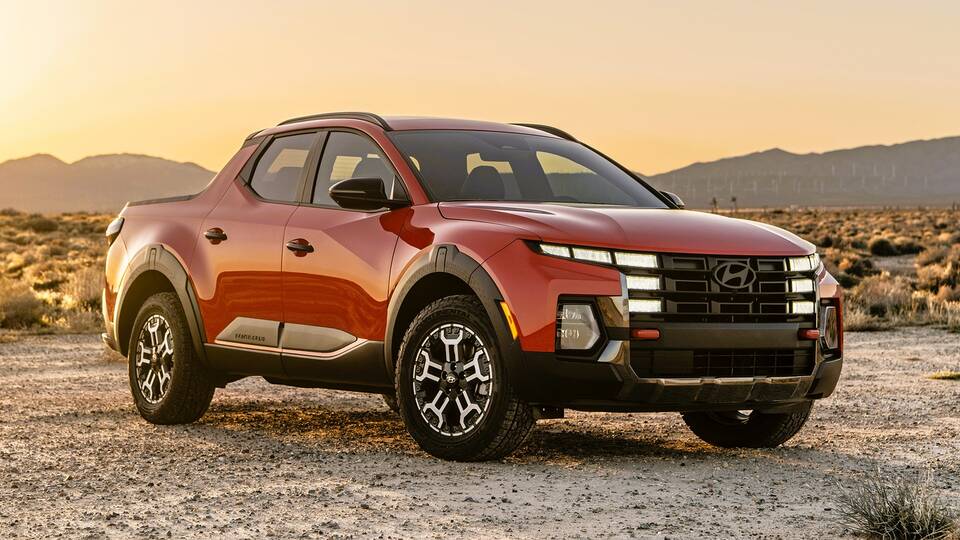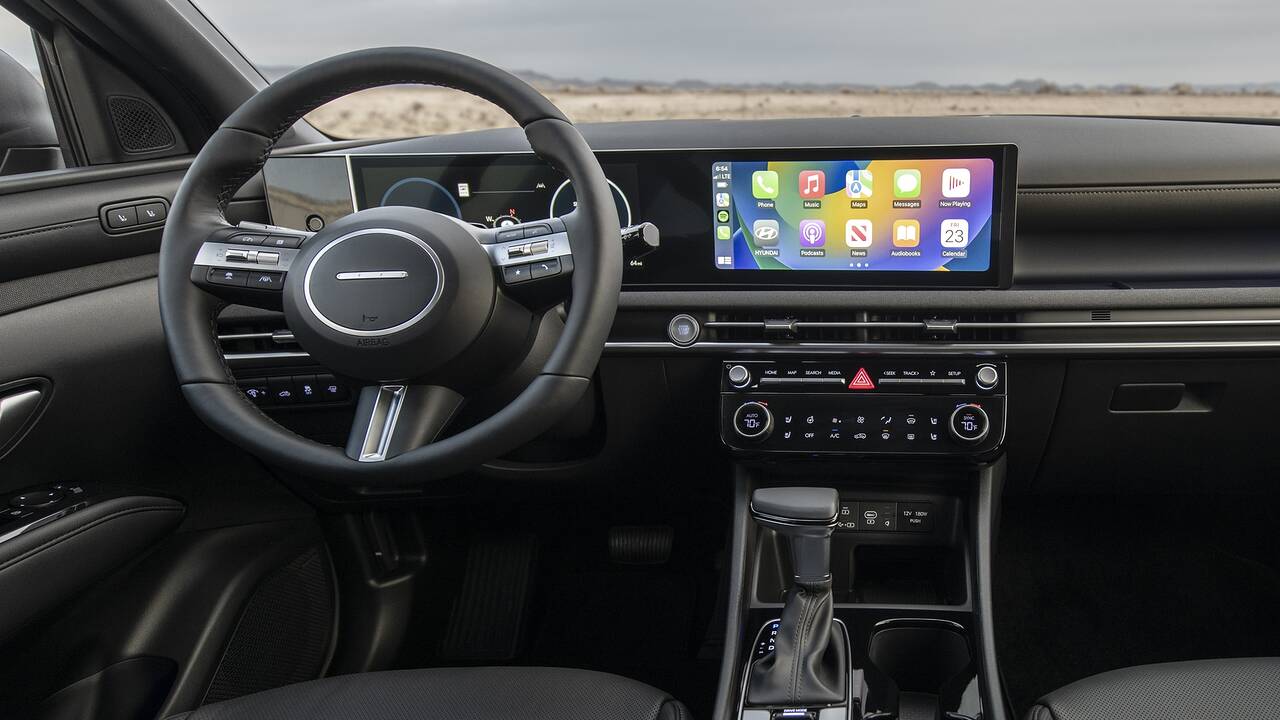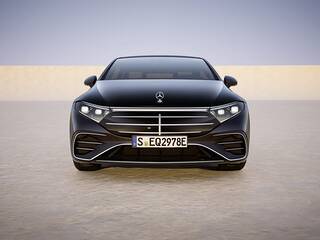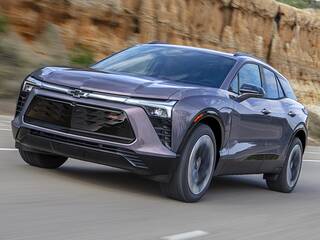The 2025 Hyundai Santa Cruz is one tweak away from greatness
Hyundai could dethrone the segment-leading Ford Maverick with a simple equipment adjustment.

published Apr 14, 2025

Key Takeaways
- The Santa Cruz's refresh for 2025 almost vaults it into first place among compact trucks, but the standard engine holds it back.
- The rival Ford Maverick's cheap turbo power should be giving Hyundai a big hint.
The 2025 Hyundai Santa Cruz's midcycle refresh was so close to being a home run. Entering its fourth year of production, Hyundai's small pickup truck has doubled down on interior artistry, introducing a widescreen infotainment module that beautifully complements the sleek dashboard and secondary controls. There's an undeniably upscale vibe inside this truck that makes the rival Ford Maverick feel basic by comparison.
But Ford's truck team knows that power matters, even when it comes to the smallest and least trucky pickups on the market. Accordingly, every non-hybrid Maverick is equipped with a punchy turbocharged four-cylinder engine that gives it the acceleration of a performance car.
And the Santa Cruz? Sure, there's an available turbo four if you don't like the standard non-turbo unit. But Hyundai only offers it at prices that would make some entry-level luxury cars blush — an unfortunate reality that the refresh did not address.
In what is likely related news, the Maverick continues to dominate the Santa Cruz in the fight for small-truck sales supremacy, moving four to five units for every Santa Cruz sold. The Ford certainly isn't four to five times better from a product standpoint, but Hyundai may have handed Ford the win by failing to compete in the engine room.
A tale of three engines
I should note here the widely reported fact that the Maverick Hybrid accounts for more than half of Maverick sales. Power isn't everything, evidently, when there's a 38-mpg alternative for about the same price.
But Hyundai has chosen to skip that fight altogether, even though the closely related and well-regarded Tucson Hybrid SUV would seem to offer a drop-in solution for a hybrid-powered Santa Cruz.
So I'll focus on the two engines that the Santa Cruz does offer, comparing them to the Maverick's single non-hybrid option. This list will be AWD-only, since the Maverick 2.0T comes standard with it, but let the record show that you can get a front-wheel-drive Santa Cruz with the base engine for $1,500 less.
2025 Hyundai Santa Cruz vs. 2025 Ford Maverick: Non-Hybrid Engine Comparison
Why the estimated acceleration time for the non-turbo Santa Cruz? Because I couldn't find a single credible test result for it on the whole internet, which gives you an idea of how eager Hyundai is to put this powertrain in the hands of third-party testers. But I did see an 8.8-second run for the Tucson Limited AWD, and the Santa Cruz 2.5 AWD is 200-250 pounds heavier, so 9 seconds flat seems about right.
Think about that for a minute. Hyundai wants at least $30,250 for the non-turbo Santa Cruz AWD, which is three seconds slower to 60 mph than the $27,570 Maverick 2.0T.
The Hyundai's optional (and AWD-only) 2.5T engine obviously solves that problem, delivering acceleration that puts it right on top of the turbocharged Maverick. But now the pricing problem rears its head. That $40,250 starting price, by the way, gets you into the 2025 Santa Cruz XRT, an off-roady trim with all-terrain tires that is pictured at the top of this article. If you don't like the outdoorsy aesthetic, your only alternative is the Santa Cruz Limited, which starts at a cool $42,750.
Your choice is clear, then, and it's not a great one. You can pay Maverick-plus money for a seriously slow Santa Cruz, which somehow loses on fuel economy as well, or you can pay literally Ford F-150 money for a Santa Cruz that can go toe-to-toe with the Maverick 2.0T.
Or maybe you just buy a Maverick. Not surprisingly, that has been by far the most popular pick.
How can Hyundai fix it?
I'm assuming here that a Santa Cruz Hybrid is out of the question, although I hope I'm wrong. But let's just focus on what Hyundai could do with the equipment that's already on hand.
What's the goal? Well, let's say that the Maverick 2.0T accounts for 45 percent of Maverick sales. Given that the Maverick had an 82 percent market share to the Santa Cruz's 18 percent in Q4 2024, per the data linked above, and seasoning that with the Santa Cruz's 21 percent sales regression in Q1 2025, we can do some napkin math and estimate that the Maverick 2.0T is outselling the entire Santa Cruz lineup by nearly two to one.
If the Santa Cruz can't compete with the Maverick Hybrid, it should at least aspire to match the sales of the Maverick 2.0T, right?
Now, if you're Hyundai, how do you double Santa Cruz sales overnight? Maybe that's aiming too high, but I do have an answer:
Bite the bullet and make the turbocharged 2.5-liter engine standard on every Santa Cruz without raising prices.

Do that and you completely change the narrative in the compact truck segment. Without the Maverick 2.0T's massive acceleration advantage, the focus would naturally shift to the Santa Cruz's elegant dashboard design, superior widescreen display and more adult-friendly backseat.
Would it be worth paying $30,250 for an entry-level Santa Cruz AWD if it had the turbo engine? I say absolutely — it would be a bona fide bargain. Hyundai could even continue to offer a front-drive version for $1,500 less, keeping the base price under the $30k threshold and squeezing out a bit more fuel economy for the fleet average.
I'm not saying this would necessarily be a profitable move, but if you want that market share, I think it's the most direct route from here to there.
And if you want the coveted #1 slot in MotorDonkey's Compact Truck Rankings, which of course you do, I can assure you that the turbo-only Santa Cruz would have a fighting chance of knocking the Maverick off its perch.
MotorDonkey says
I've spent a fair amount of time behind the wheel of the turbocharged Santa Cruz, even tossing it around on a racetrack for a few laps. That turbo motor is just a great fit for the truck, providing ample torque (311 lb-ft is no joke) and all the full-throttle acceleration you could ask for. Combined with the Santa Cruz's other strengths for around $30k to start, it could win a lot of converts to this worthy pickup's cause.
But as things stand, it's just too easy to make the case for the Maverick 2.0T, plain and simple. Hyundai needs to take more drastic action than the 2025 refresh, I'm afraid, if the Santa Cruz is going to flip this script. ⛐ md

by Josh Sadlier
Publisher and Donkey-in-Chief
Josh has been reviewing cars professionally since joining Edmunds.com fresh out of grad school in 2008. Prior to founding MotorDonkey, he spent 15 years shaping Edmunds' expert automotive content in various capacities, starting as an associate editor and ultimately serving as a senior editor before wrapping up with a five-year term as the company's first-ever director of content strategy. Josh is a card-carrying member of the Motor Press Guild and a lifelong car nut who has driven, compared and critiqued thousands of cars in his career. Helping people find their perfect car never gets old—seriously!
 Let's make it official!
Let's make it official!
Be a good donkey and we'll deliver delicious car news straight to your inbox, spam-free forever.


